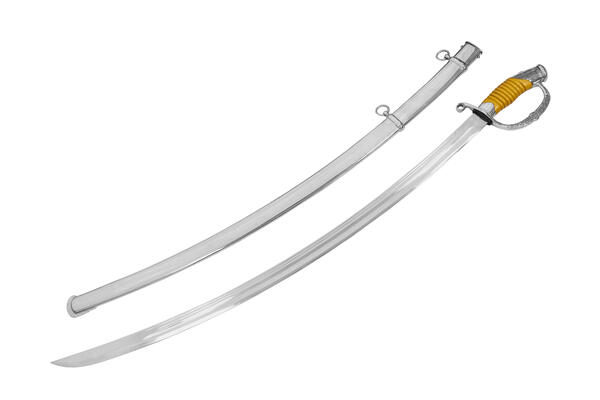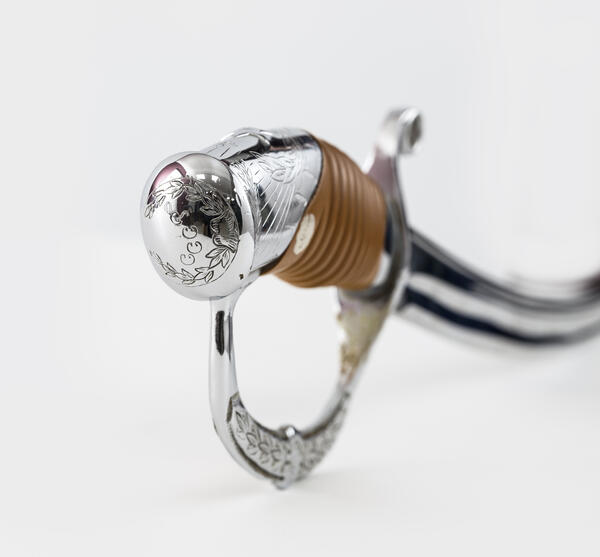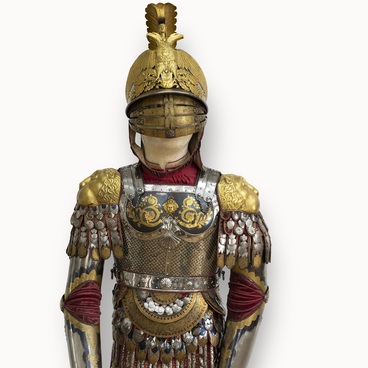For the historic Victory Day Parade in 1945, the Zlatoust plant named after Vladimir Lenin made general’s and officer’s sabers, army knives, daggers, as well as cadet broadswords. All the generals participating in the Parade were armed with general’s sabers of the 1940 model.
Between 1940 and 1941, the plant’s gunsmiths made 810 items of this model. With the beginning of the Great Patriotic War, the production of sabers was suspended until 1944–1945. Throughout that period, Zlatoust gunsmiths made 624 weapons.
The production of general’s sabers continued into the 1950s. At that time, they were given to every soldier who received the rank of general. This practice was later abolished. Until the late 1990s, the general’s saber of the 1940 model was part of the ceremonial uniform of Soviet generals who led the columns at parades, as well as that of officers — commanders of guards of honor.
The steel blade of the general’s saber of the 1940 model is single-edged and has one wide and two narrow fullers. The hilt consisted of a handle with a pommel and a guard. The handle was made of a yellow synthetic resin called neoleykorite, while the metal parts of the hilt were made of brass, an alloy of copper.
The figured handle is oval, with a thickened middle part, deep transverse grooves and a slight bend towards the blade. The upper part of the handle was adorned with a composition of a five-pointed star and a sickle and a hammer against the background of diverging rays and a pattern of oak leaves.
The pommel of the hilt is oval and convex. It was decorated with the inscription “USSR” enclosed in a laurel wreath. The lower part of the handle is figured. The guard is formed by a protective knuckle bow, which starts in the upper part of the handle and blends into the quillon.
At the end of the quillon, a hole was made for a lanyard (a belt or a ribbon on the hilt of a sword or a saber, secured on the hand when using a weapon). The scabbards were made of steel. They were oval and slightly curved and consisted of a flat throat with two screws and two lockets fitted with rings for the sword belt. The blade, the scabbard and the guard were plated with nickel at the factory.
Between 1940 and 1941, the plant’s gunsmiths made 810 items of this model. With the beginning of the Great Patriotic War, the production of sabers was suspended until 1944–1945. Throughout that period, Zlatoust gunsmiths made 624 weapons.
The production of general’s sabers continued into the 1950s. At that time, they were given to every soldier who received the rank of general. This practice was later abolished. Until the late 1990s, the general’s saber of the 1940 model was part of the ceremonial uniform of Soviet generals who led the columns at parades, as well as that of officers — commanders of guards of honor.
The steel blade of the general’s saber of the 1940 model is single-edged and has one wide and two narrow fullers. The hilt consisted of a handle with a pommel and a guard. The handle was made of a yellow synthetic resin called neoleykorite, while the metal parts of the hilt were made of brass, an alloy of copper.
The figured handle is oval, with a thickened middle part, deep transverse grooves and a slight bend towards the blade. The upper part of the handle was adorned with a composition of a five-pointed star and a sickle and a hammer against the background of diverging rays and a pattern of oak leaves.
The pommel of the hilt is oval and convex. It was decorated with the inscription “USSR” enclosed in a laurel wreath. The lower part of the handle is figured. The guard is formed by a protective knuckle bow, which starts in the upper part of the handle and blends into the quillon.
At the end of the quillon, a hole was made for a lanyard (a belt or a ribbon on the hilt of a sword or a saber, secured on the hand when using a weapon). The scabbards were made of steel. They were oval and slightly curved and consisted of a flat throat with two screws and two lockets fitted with rings for the sword belt. The blade, the scabbard and the guard were plated with nickel at the factory.





